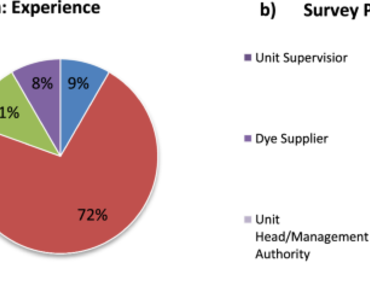Development of an effective strategy using green synthesized nanoparticles to decolorize a representative dye used in textile industries of Sanganer, Jaipur (India)
Research Articles | Published: 17 January, 2023
First Page: 154
Last Page: 162
Views: 2994
Keywords: Nanoremediation, Dye, Textile industry, Decolorisation, Sanganer
Abstract
Sanganer, an area situated in Jaipur Rajasthan, is known for its world-class textile printing with origin tracing back to pre colonial times. The region has currently been marked with heavy pollution from textile industries. The study therefore has been designed to find out the most prevalent dyes used in the textile industries of Sanganer through a field survey which indicated an increasing prevalence of synthetic dyes with decreasing popularity of natural dyes. One of the most used industrial dyes; brilliant blue has been used as a model in the current study to develop an effective strategy for decolorisation of industrial dyes. The developed strategy employed green synthesized iron oxide nanoparticles (IONPs). It was observed that the nanoparticles were effective in decolorisation of brilliant blue up to 90.87 ± 0.08% within 9.30 min. Optimization using Taguchi design revealed that a concentration of 1 g/l of dye, 2.4 × 1011 particles of IONP/ml at pH 10.0 were optimum conditions for maximum decolorisation. Kinetic studies showed that the decolorisation reaction was of mixed order type. FTIR spectra of the dye depicted drastic change in peaks in the post treatment samples. The shifts can be assigned to O–H, CH3 asymmetric stretching, –CH aliphatic, C=C, –CH2 bending, and C–H bending respectively.

References
Bendell A et al (eds) (1989) Taguchi methods. McGraw-Hill, New York
Desore A, Narula SA (2017) An overview on corporate response towards sustainability issues in textile industry. Environ Dev Sustain 20:1439–1459
Dhananasekaran S, Palanivel R, Pappu S (2016) Adsorption of methylene blue, bromophenol blue, and Coomassie Brilliant Blue by α-chitin nanoparticles. J Adv Res 7:113–124
Elkady M, Shokry H, Hamad H (2020) New activated carbon from mine coal for adsorption of dye in simulated water or multiple heavy metals in real wastewater. Materials 13:2498
Hendel T, Wuithschick M, Kettemann F, Birnbaum A, Rademann K, Polte J (2014) In situ determination of colloidal gold concentrations with UV–VIS spectroscopy: limitations and perspectives. Anal Chem 86(22):11115–11124. https://doi.org/10.1021/ac502053s
Huízar-Félix A, Aguilar-Flores C, Martínez-de-la Cruz A, Barandiarán J, Sepúlveda-Guzmán S, Cruz-Silva R (2019) Removal of tetracycline pollutants by adsorption and magnetic separation using reduced graphene oxide decorated with α-fe2o3 nanoparticles. Nanomaterials 9:313
Madan SS, Wasewar KL (2017) Optimization for benzene acetic acid removal from aqueous solution using Cao 2 nanoparticles based on Taguchi Method. Jappl Res Technol 15:332–339
Madan S, Madan R, Hussain A (2022) Evaluation of corrosion and scaling tendency of polyester textile dyeing effluent, Haridwar, Uttarakhand, India. Environ Sci Pollut Res 8:47
Mokhtar MAZ, Ali RR, Isa EDM (2021) Silver nanoparticles loaded activated carbon synthesis using CLITOREA ternatea extract for crystal violet dye removal. J Nanosci Nanotechnol 3:26–36
Osman MS, Kong LP, Zamanhuri NA, Lim JK (2015) Role of temperature and ph on the dye degradation using magnetic nanoparticles augmented polymeric microcapsule. Adv Mat Res 1113:566–570
Parvin F, Nayna OK, Tareq SM, Rikta SY, Kamal AKI (2018) Facile synthesis of iron oxide nanoparticle and synergistic effect of iron nanoparticle in the presence of sunlight for the degradation of dom from textile wastewater. Appl Water Scidoi. https://doi.org/10.1007/s13201-018-0719-5
Patel D, Bhatt S (2022) Environmental pollution, toxicity profile, and physicochemical and biotechnological approaches for treatment of textile wastewater. Biotechnol Genet Eng Rev 38(1):33–86
Raychoudhury T, Scheytt T (2013) Potential of zerovalent iron nanoparticles for remediation of environmental organic contaminants in water: a review. Water Sci Technol 68(7):1425–1439. https://doi.org/10.2166/wst.2013.358
Sadegh H, Ali GA, Gupta VK, Makhlouf AS, Shahryari-ghoshekandi R, Nadagouda MN, Sillanpää M, Megiel E (2017) The role of nanomaterials as effective adsorbents and their applications in wastewater treatment. J Nanostructure Chem 7:1–14
Sahoo TR, Prelot B (2020) Adsorption processes for the removal of contaminants from wastewater. Nanomater Detect Removal Wastewater Pollut 2020:161–222
Salam MA, Kosa SA, Al-Beladi AA (2017) Application of nanoclay for the adsorptive removal of Orange G dye from aqueous solution. J Mol Liq 241:469–477. https://doi.org/10.1016/j.molliq.2017.06.055
Sarvari H, Goharshadi EK, Samiee S, Ashraf N (2013) Removal methyl orange from aqueous solutions using dragon fruit (Hylocereusundatus) foliage. Chem Sci Trans. https://doi.org/10.7598/cst2013.439
Shahnawaz H, Kriplani C, Iqbal MA (2019) Investigations on quality of ground water seasonal variations in Sanganer Tehsil, Jaipur (Rajasthan). SSRN Electron J 2019:1256
Sharma B, Menon S, Mathur S, Kumari N, Sharma V (2020) Decolorization of Malachite Green Dye from aqueous solution using biosurfactant-stabilized iron oxide nanoparticles: process optimization and reaction kinetics. Int J Environ Sci Technol 18:1739–1752
Tan KB, Vakili M, Horri BA, Poh PE, Abdullah AZ, Salamatinia B (2015) Adsorption of dyes by nanomaterials: recent developments and adsorption mechanisms. Sep Purif Technol 150:229–242. https://doi.org/10.1016/j.seppur.2015.07.009
Wang DM (2016) Environmental protection in clothing industry. In: Zhu L (ed) Sustainable development: proceedings of the 2015 international conference on sustainable development (ICSD2015) (pp 729–735). World Scientific Publishing Co Pte Ltd, Singapore
Yaseen DA, Scholz M (2018) Textile dye wastewater characteristics and constituents of synthetic effluents: a critical review. Int J Environ Sci Technol 16(2):1193–1226
Author Information
Amity Institute of Biotechnology, Amity University Rajasthan, Jaipur, India